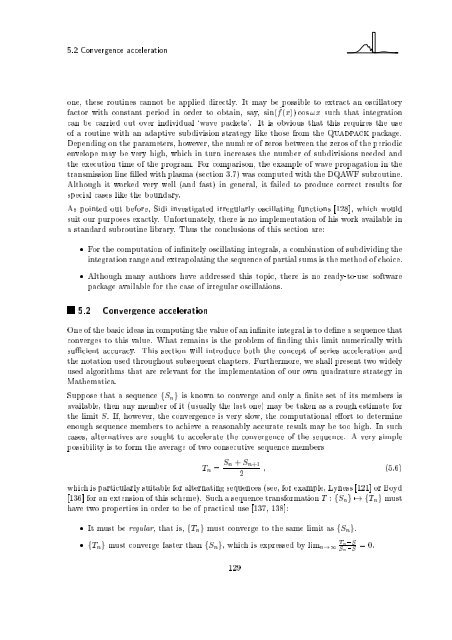Wave Propagation in Linear Media | re-examined
Wave Propagation in Linear Media | re-examined
Wave Propagation in Linear Media | re-examined
You also want an ePaper? Increase the reach of your titles
YUMPU automatically turns print PDFs into web optimized ePapers that Google loves.
5.2 Convergence acceleration<br />
one, these rout<strong>in</strong>es cannot be applied di<strong>re</strong>ctly. It may be possible to extract an oscillatory<br />
factor with constant period <strong>in</strong> order to obta<strong>in</strong>, say, s<strong>in</strong>( ~ f(x)) cos !x such that <strong>in</strong>tegration<br />
can be carried out over <strong>in</strong>dividual `wave packets'. It is obvious that this <strong>re</strong>qui<strong>re</strong>s the use<br />
of a rout<strong>in</strong>e with an adaptive subdivision strategy like those from the Quadpack package.<br />
Depend<strong>in</strong>g on the parameters, however, the number of zeros between the zeros of the periodic<br />
envelope may be very high, which <strong>in</strong> turn <strong>in</strong>c<strong>re</strong>ases the number of subdivisions needed and<br />
the execution time of the program. For comparison, the example of wave propagation <strong>in</strong> the<br />
transmission l<strong>in</strong>e lled with plasma (section 3.7) was computed with the DQAWF subrout<strong>in</strong>e.<br />
Although it worked very well (and fast) <strong>in</strong> general, it failed to produce cor<strong>re</strong>ct <strong>re</strong>sults for<br />
special cases like the boundary.<br />
As po<strong>in</strong>ted out befo<strong>re</strong>, Sidi <strong>in</strong>vestigated ir<strong>re</strong>gularly oscillat<strong>in</strong>g functions [128], which would<br />
suit our purposes exactly. Unfortunately, the<strong>re</strong> is no implementation of his work available <strong>in</strong><br />
a standard subrout<strong>in</strong>e library. Thus the conclusions of this section a<strong>re</strong>:<br />
For the computation of <strong>in</strong> nitely oscillat<strong>in</strong>g <strong>in</strong>tegrals, a comb<strong>in</strong>ation of subdivid<strong>in</strong>g the<br />
<strong>in</strong>tegration range and extrapolat<strong>in</strong>g the sequence of partial sums is the method of choice.<br />
Although many authors have add<strong>re</strong>ssed this topic, the<strong>re</strong> is no <strong>re</strong>ady-to-use softwa<strong>re</strong><br />
package available for the case of ir<strong>re</strong>gular oscillations.<br />
5.2 Convergence acceleration<br />
One of the basic ideas <strong>in</strong> comput<strong>in</strong>g the value of an <strong>in</strong> nite <strong>in</strong>tegral is to de ne a sequence that<br />
converges to this value. What <strong>re</strong>ma<strong>in</strong>s is the problem of nd<strong>in</strong>g this limit numerically with<br />
su cient accuracy. This section will <strong>in</strong>troduce both the concept of series acceleration and<br />
the notation used throughout subsequent chapters. Furthermo<strong>re</strong>, we shall p<strong>re</strong>sent two widely<br />
used algorithms that a<strong>re</strong> <strong>re</strong>levant for the implementation of our own quadratu<strong>re</strong> strategy <strong>in</strong><br />
Mathematica.<br />
Suppose that a sequence fSng is known to converge and only a nite set of its members is<br />
available, then any member of it (usually the last one) may be taken as a rough estimate for<br />
the limit S. If, however, the convergence is very slow, the computational e ort to determ<strong>in</strong>e<br />
enough sequence members to achieve a <strong>re</strong>asonably accurate <strong>re</strong>sult may be too high. In such<br />
cases, alternatives a<strong>re</strong> sought to accelerate the convergence of the sequence. A very simple<br />
possibility is to form the average of two consecutive sequence members<br />
Tn = Sn + Sn+1<br />
2<br />
; (5.6)<br />
which is particularly suitable for alternat<strong>in</strong>g sequences (see, for example, Lyness [121] or Boyd<br />
[136] for an extension of this scheme). Such a sequence transformation T : fSng 7!fTngmust<br />
have two properties <strong>in</strong> order to be of practical use [137, 138]:<br />
It must be <strong>re</strong>gular, that is, fTng must converge to the same limit as fSng.<br />
fTng must converge faster than fSng, which is exp<strong>re</strong>ssed by limn!1 Tn,S<br />
Sn,S =0.<br />
129












